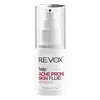What's inside
What's inside
 Key Ingredients
Key Ingredients

 Benefits
Benefits

 Concerns
Concerns

No concerns
 Ingredients Side-by-side
Ingredients Side-by-side

Water
Skin ConditioningGlycerin
HumectantDipropylheptyl Carbonate
EmollientCetyl Alcohol
EmollientDicaprylyl Ether
EmollientGlucomannan
Skin ConditioningPanthenol
Skin ConditioningHydroxyacetophenone
AntioxidantSodium Stearoyl Glutamate
CleansingDistarch Phosphate
AbsorbentAllantoin
Skin ConditioningDipotassium Glycyrrhizate
Humectant1,2-Hexanediol
Skin ConditioningCaprylyl Glycol
EmollientZinc PCA
HumectantTocopherol
AntioxidantChondrus Crispus Powder
AbrasiveMadecassoside
AntioxidantLactic Acid
BufferingWater, Glycerin, Dipropylheptyl Carbonate, Cetyl Alcohol, Dicaprylyl Ether, Glucomannan, Panthenol, Hydroxyacetophenone, Sodium Stearoyl Glutamate, Distarch Phosphate, Allantoin, Dipotassium Glycyrrhizate, 1,2-Hexanediol, Caprylyl Glycol, Zinc PCA, Tocopherol, Chondrus Crispus Powder, Madecassoside, Lactic Acid
Water
Skin ConditioningGlycerin
HumectantAlcohol Denat.
AntimicrobialIsododecane
EmollientDimethicone/Bis-Isobutyl PPG-20 Crosspolymer
EmollientAmmonium Acryloyldimethyltaurate/Vp Copolymer
Silica
AbrasiveUrea
BufferingSodium Salicylate
PreservativeBisabolol
MaskingNiacinamide
SmoothingOctyldodecanol
EmollientCaprylic/Capric Triglyceride
MaskingSuccinic Acid
BufferingParfum
MaskingPhenoxyethanol
PreservativeDisodium EDTA
Styrene/Acrylates Copolymer
Coco-Glucoside
CleansingWater, Glycerin, Alcohol Denat., Isododecane, Dimethicone/Bis-Isobutyl PPG-20 Crosspolymer, Ammonium Acryloyldimethyltaurate/Vp Copolymer, Silica, Urea, Sodium Salicylate, Bisabolol, Niacinamide, Octyldodecanol, Caprylic/Capric Triglyceride, Succinic Acid, Parfum, Phenoxyethanol, Disodium EDTA, Styrene/Acrylates Copolymer, Coco-Glucoside
 Reviews
Reviews

Ingredients Explained
These ingredients are found in both products.
Ingredients higher up in an ingredient list are typically present in a larger amount.
Glycerin is already naturally found in your skin. It helps moisturize and protect your skin.
A study from 2016 found glycerin to be more effective as a humectant than AHAs and hyaluronic acid.
As a humectant, it helps the skin stay hydrated by pulling moisture to your skin. The low molecular weight of glycerin allows it to pull moisture into the deeper layers of your skin.
Hydrated skin improves your skin barrier; Your skin barrier helps protect against irritants and bacteria.
Glycerin has also been found to have antimicrobial and antiviral properties. Due to these properties, glycerin is often used in wound and burn treatments.
In cosmetics, glycerin is usually derived from plants such as soybean or palm. However, it can also be sourced from animals, such as tallow or animal fat.
This ingredient is organic, colorless, odorless, and non-toxic.
Glycerin is the name for this ingredient in American English. British English uses Glycerol/Glycerine.
Learn more about GlycerinWater. It's the most common cosmetic ingredient of all. You'll usually see it at the top of ingredient lists, meaning that it makes up the largest part of the product.
So why is it so popular? Water most often acts as a solvent - this means that it helps dissolve other ingredients into the formulation.
You'll also recognize water as that liquid we all need to stay alive. If you see this, drink a glass of water. Stay hydrated!
Learn more about Water